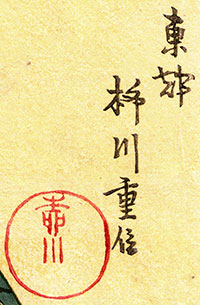 |
Yanagawa Shigenobu I print from 6/1822
Hinaji-dayû (雛治太夫) of the Higashi-Ôgiya (東扇屋)
as Tawara Tôda (俵藤太)
Series: Osaka Shinmachi nerimono
(Costume parade in Shinmachi: 大坂新町祢りもの) |
|
 Yanagawa Shigenobu I (柳川重信 1787–1832, act. c. 1810s–1832) was an Edo artist who worked briefly in Osaka (1822-25). One of his Edo addresses was in Honjo Yanagawa-chô, which gave rise to his surname "Yanagawa" (柳川). He was a pupil, then son-in-law, and finally adopted son of the Edo master artist Katsushika Hokusai (葛飾北齋 1760-1849), although Shigenobu's work also reveals some influence from Utagawa Kunisada. Over the course of his active years, Shigenobu designed ehon (illustrated books: 絵本), prints, and paintings. He covered several genres, including yakusha-e (actor portraits: 役者絵), bijinga (pictures of beautiful women: 美人画), fûkeiga (landscapes: 風景画), surimono (privately issued specialty prints: 摺物) on various themes, and shunga (explicit erotica: 春画). Yanagawa Shigenobu I (柳川重信 1787–1832, act. c. 1810s–1832) was an Edo artist who worked briefly in Osaka (1822-25). One of his Edo addresses was in Honjo Yanagawa-chô, which gave rise to his surname "Yanagawa" (柳川). He was a pupil, then son-in-law, and finally adopted son of the Edo master artist Katsushika Hokusai (葛飾北齋 1760-1849), although Shigenobu's work also reveals some influence from Utagawa Kunisada. Over the course of his active years, Shigenobu designed ehon (illustrated books: 絵本), prints, and paintings. He covered several genres, including yakusha-e (actor portraits: 役者絵), bijinga (pictures of beautiful women: 美人画), fûkeiga (landscapes: 風景画), surimono (privately issued specialty prints: 摺物) on various themes, and shunga (explicit erotica: 春画).
Shigenobu is particularly admired for his surimono, many of which he produced while collaborating in Osaka with the superbly gifted block carver Tani Seikô (谷清好 act. c. 1810s-1831 in Edo and Osaka). It is widely considered that it was Seikô who produced nearly all of the finest surimono issued in Osaka during his most active period (1822-1831). Shigenobu was the first among a number of Edo artists who designed surimono and single-sheet commercial prints in Osaka; others included Yashima Gakutei (八島岳亭; 1786-1868) and Katsushika Taito II (二代 葛飾戴斗 act. c. 1810-1853). Soon after his arrival in Osaka, Shigenobu collaborated with Seikô and the Tsuru-ren (Crane poetry circle: 鶴連) on a set of what was probably ten shikishiban (square surimono: 色紙判) portraits of costumed geisha in the fifth month of 1822. In the first month of 1823, Shigenobu and Seikô worked together on a deluxe book with fifty portraits of poets from the Tsuru-ren (Crane poetry circle: 鶴連), all of which Shigenobu had drawn. The compilation was titled Kyôka gojûnin isshu (Fifty playful-verse poets: 狂歌五十人一首). Moreover, in 1823 and 1824, Shigenobu also worked on at least eighteen prints for the same Crane group of poets. A fine example of such a surimono circa 1/1823 is shown on the page linked at the bottom of this text.
Shigenobu also designed some of his best work in Osaka when he produced around thirteen to fifteen designs for a series of deluxe ôban prints depicting geisha for the series Osaka Shinmachi nerimono (Costume parade in Shinmachi: 大坂新町祢りもの) circa 6/1822. Shinmachi ("New Quarters": 新町) was Osaka's official licensed pleasure quarter. Both it and the Shimanouchi (lit., "inside the island": 島の内), an unlicensed district to the southwest, hosted nerimono sugata (costume parades: ねり物姿) featuring waitresses, geisha, and courtesans performing skits or pantomimes about well-known figures from contemporary society, theater, history, and legend. In this colorful pageant, the women were often accompanied by decorative floats carrying musicians and dancers. In the print illustrated on the left, Hinaji-dayû (雛治太夫) of the Higashi-Ôgiya (東扇屋) is shown performing in a skit as Tawara Tôda (俵藤太). Tawara [Fujiwara no Hidesato] was a courageous rônin (masterless samurai: 浪人) who kills a monstrous centipede responsible for destroying the watery domain of Oto-hime (Princess Oto) at Lake Biwa. For more about this print, see Shigenobu I.
Yanagawa Shigenobu I's Names
Surnames (geimei):
Suzuki (鈴木)
Yanagawa (柳川)
Art pseudonyms (gô):
Raito (雷斗)
Kinsai (琴齋)
Reisai (鈴齋)
Ushôsai (雨蕉齋)
For more information about Yanagawa Shigenobu I, see John Fiorillo's web page:
https://viewingjapaneseprints.net/texts/ukiyoe/shigenobu.html.
|